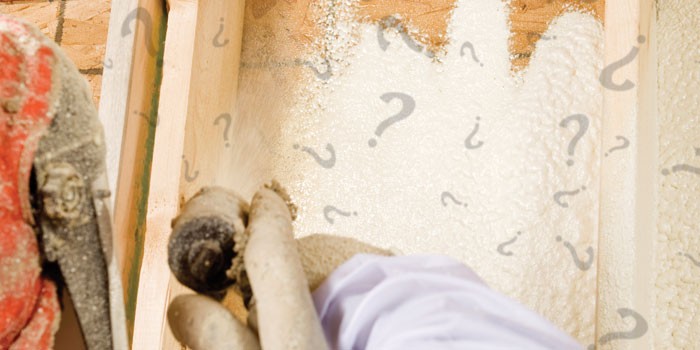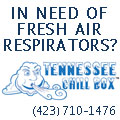FAQ for Building Code Officials
Question:
Can spray polyurethane insulation
be applied directly to electrical wiring? What about installed electrical
devices like recessed lights?
Answer:
Answers to questions related to the use of spray foams and the building
codes are based on the 2009 International Code Council series of publications:
International Building Code (IBC), International Residential Code (IRC) and
International Energy Efficiency Code (IECC). State and local codes may
deviate from these code publications, so these answers could be slightly
different from state and local regulations.
Spray
polyurethane foam can be applied directly to electrical wiring. Recessed lights
or other fixtures may require a certain amount of air circulation around them
for cooling purposes. In these cases, a box can be built around the fixture
with gypsum wall board; then spray foam can be sprayed directly to the outside
of the box.
Question:
Can you insulate non-vented roof
decks and attics with foam?
Answer:
Answers to questions related to the use of spray foams and the building
codes are based on the 2009 International Code Council series of publications:
International Building Code (IBC), International Residential Code (IRC) and
International Energy Efficiency Code (IECC). State and local codes may
deviate from these code publications, so these answers could be slightly
different from state and local regulations.
YES, with just about all brands of spray polyurethane foams. The
International Code Council (ICC) Residential Code provides guidance for the
proper design and installation for non-vented attic assemblies in the
Residential Code (IRC) section R806.4. This design is now referred to as
“Unvented attic assemblies”.
While there is over 30 years of building unvented attics using SPF with
local code approvals, the nationally known code bodies first authorized it in
2004. This approval has been modified and clarified in subsequent editions of
the ICC Residential Code with the current 2009 issue having very good detailed
instructions on the proper design and installation.
In all but the warmest/driest climate zones of the United States, the
insulation used to insulate and seal off an unvented attic assembly must be an
air-impermeable insulation, which just about all spray foams are, open and
closed cell. Applicators should be sure the SPF manufacturer they choose to
supply their material has certified the system as air-impermeable and at what
minimum thickness.
Question:
What is the difference between a thermal barrier and an ignition barrier?
Answer:
Thermal barriers are required by code to be installed between foam plastic,
such as spray polyurethane foam, and the interior space of a home or commercial
building. The most commonly used thermal barrier is gypsum wallboard found on
the walls and ceiling. Ignition barriers serve a different purpose and are only
used in attics and crawlspaces. A typical ignition barrier is ¼” plywood
installed over the foam plastic. Some spray polyurethane foam manufacturers
have their own spray-on liquid applied intumescent coatings that have been
tested and approved to be used over their foam as thermal barriers and/or
ignition barriers. The following paragraphs go into further detail about how
the building codes classify them, common interpretations of the code in regards
to each and the tests that are used to qualify each.
Spray foams are one form of “foam plastic”. Building codes (IBC & IRC)
stipulate that foam plastic insulation shall be separated from the interior of
a building by an approved thermal barrier of ½ inch gypsum wallboard or
equivalent thermal barrier material. (There are also exceptions to this in the
codes, but they will not be addressed here). In most interior applications, the
gypsum wallboard is used to satisfy the requirement. In requiring the foam
plastic to be “separated from the interior” there is no stipulation for the
thermal barrier to be in contact with the foam plastic, nor is there any
maximum distance stipulated between the foam plastic and the thermal barrier.
It is fairly common to find applications with the thermal barrier a couple of
feet away from the spray foam surface, and this is acceptable and within the
requirement of the code.
Other approved forms of Thermal Barriers are cementitious or fiber based
materials applied to the foam surface. These materials must pass two tests; one
for temperature and one for the ability to remain in place in order to be
classified as a “thermal barrier”. These materials are tested per the
requirements of the building code and can be installed on any spray foam system.
There are some coatings (usually intumescent coatings) that have been tested
so the combination foam/coating does not require a thermal barrier. The coating
is not a “thermal barrier” but can be used in lieu of the required thermal
barrier. If the coating is tested only on vertical walls, it is only
approved for use on vertical walls. If the coating is tested only on overhear
horizontal ceiling assemblies, it can only be used in place of a thermal
barrier for overhead applications. The thickness of the spray foam
membrane can not exceed that which was used in the coating test. The coating is
also restricted to only the specific spray foam system used in the test. To
determine these limitations requires a review of the test report or some type
of Evaluation Report stipulating the coating approvals.
Ignition Barrier: When spray foam is installed in an attic or crawl
space where there is an opening which would permit a person to climb into the
space (limited access) the building code requires the installation of an
ignition barrier over the exposed surface of the spray foam. Ignition barriers
are ONLY used in attics and crawl spaces. The IBC and IRC list 6 ignition
barriers. These are the only ignition barriers. The code does
provide guidance for testing the installation of spray foams without an
ignition barrier. Many spray foam manufacturers test their spray foam systems
with an intumescent coating in place of the ignition barrier. When the
coating/foam combination passes the screening test, the combination is approved
for use in the attics and crawl spaces, but the coating is not recognized in
the building codes as an ignition barrier; instead, it is referred to as an
installation without an ignition barrier. Where the building code provides the
method to test a product and certify it as a Thermal Barrier, there is no
provision in the building code to test and certify a product as an “ignition
barrier”; therefore any coating or other covering is not an “Ignition Barrier”,
but is an approved installation without an ignition barrier. If the same test
is passed by a spray foam system with no coating or ignition barrier, then that
spray foam system will be approved for installation with no additional
covering/coating.
The most definitive and recognized guidance on testing spray foam without an
ignition barrier is written in the Acceptance Criteria (AC 377) for spray foams
published by the International Code Council Evaluation Services (ICC-ES). This
publication can be found on the ECC-ES web site. www.icc-es.com
An attic is the space between the bottom of the roof deck and the ceiling.
The ceiling has to be fixed in place to constitute an attic, as in gypsum board
nailed/screwed to the ceiling rafters/joist. Drop in ceiling panels into a
metal grid suspended from the roof deck does not constitute an attic space.
Therefore, in reality, the ceiling is the Thermal Barrier between the
spray foam and the interior of the building and the floor decking/subfloor is
the thermal barrier between the spray foam in a crawl space and the interior of
the building. There is no code stipulation that the thermal barrier be within a
specified distance of the spray foam surface. In many cases the separation will
be some feet in distance.
An attic space may be created behind a knee wall when constructing a bonus
room in the area typically left as attic space. If no access hatch into this
space is required by other code stipulations, there is no requirement for an ignition
barrier on the spray foam behind a gypsum board knee wall, because there is no
access.
The key rule for Ignition Barriers…..they only come into consideration in an
attic space with access (and no storage flooring permitted) and crawl spaces
(all of which are required to have access). Basements are part of the interior
of the building. Basement or ground level garage spaces are part of the
interior of the building. Ignition barriers are not used in work shops,
insulated storage sheds, detached garages, parking decks or any other such
building.
Question:
What would be the proper
thickness of closed cell foam to be applied to a crawl space under a house in
North Florida?
Answer:
Check with your local
building code official, but the International Energy Concervation Code states
and R-13 is required under the floor.
Question:
How can I tell the difference
between closed-cell foam and open-cell foam when I am doing inspections?
Answer:
Here we will discuss insulation spray foams. Roofing spray foams are all
closed-cell and any suspicion that the membrane foam has open cells from an
“off ratio” misapplication will require sample analysis in a lab.
The first item for an inspection should be the Installer’s Certificate
listing the type system being inspected.
With no other documentation or evidence of system properties, the simplest
means is by gently touching the foam surface, with open cell having a soft
cushion feel and closed cell having a harder rigid feel. One should take care
not to push on the foam surface enough to damage the open cell membrane. Unlike
flexible cushion polyurethane foams used for bedding and furniture cushions
(which can be squeezed and spring back into shape) spray foams do not have the
same recovery properties and may be compressed beyond the recovery point. This
is particularly true with open cell systems.
Open-cell systems with a density measurement of 0.5 pounds per cubic foot
are very soft. By comparison, closed cell insulation systems have a density
measurement of 2.0 pound per cubic foot and are much stronger and harder.
Lately, some alternate products are being introduced to the market with higher
density open cell 2.0 systems and lower density closed cell 1.7 to 1.2 systems.
As these systems find wider acceptance in the construction industry, inspector
may be required to rely more on the Certifications by the installer.
Question:
Is spray polyurethane insulation
code approved?
Answer:
Yes. Building codes
provide for the use of spray polyurethane insulation in the Foam Plastic
section. This section of the code also describes the use of thermal barriers.
Question:
What is a thermal barrier and when is it needed?
Answer:
Answers to questions related to the use of spray foams and the building
codes are based on the 2009 International Code Council series of publications:
International Building Code (IBC), International Residential Code (IRC) and
International Energy Efficiency Code (IECC). State and local codes may
deviate from these code publications, so these answers could be slightly
different from state and local regulations.
A thermal barrier is a covering between
the interior space of a building and the surface of the spray polyurethane
insulation which will protect it for at least 15 minutes as tested in an ASTM
test. ½-inch gypsum wall board, such as Sheetrock®, is an approved 15-minute
thermal barrier. Building codes require the installation of a thermal barrier
between foam plastics (such as spray polyurethane insulation) and any occupied
space. Exceptions apply in some cases; review local codes and/or confer with
your local building code officials. The building code provides for an exception
to the thermal barrier requirement in attics and crawl spaces where entry is
made only for the service of utilities. In such cases, the spray polyurethane
insulation must be protected from ignition. There are many spray-on ignition
barrier coatings for these areas.




























